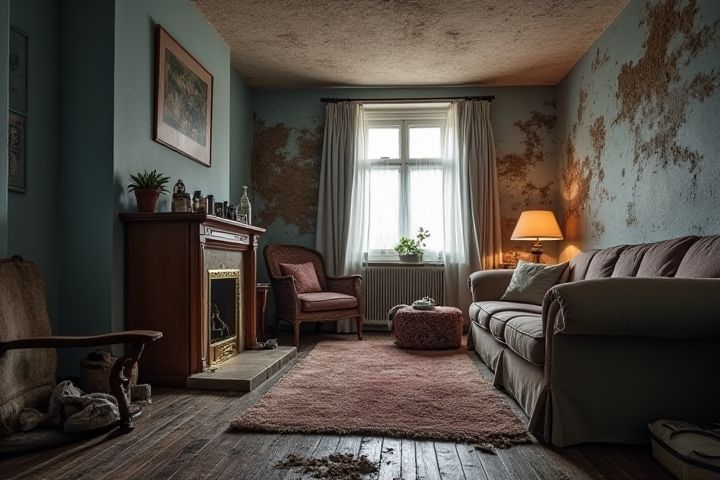
Your house may be losing heat due to insufficient insulation in walls, attics, or floors, allowing warm air to escape. Drafts from windows, doors, or other openings can create cold spots, contributing to a drop in indoor temperature. Ineffective or aging heating systems may not distribute warmth evenly, resulting in colder areas. Additionally, poorly sealed ductwork can lead to heated air escaping before reaching your living spaces. Conducting an energy audit can help you identify and fix these issues, enhancing your home's energy efficiency and comfort.
Why Is My House Losing Heat
Poor insulation
Poor insulation can significantly cause your house to lose heat, leading to increased energy bills and discomfort. Around 30% of heat can escape through the walls if they are inadequately insulated, while roofs can account for another 25%. Areas like windows and doors, if unsealed or poorly insulated, might contribute up to 10% more heat loss. Enhancing your insulation with materials like fiberglass or spray foam can help maintain a consistent indoor temperature and reduce your heating expenses.
Air leaks
Air leaks in your home can significantly contribute to heat loss, making your living space feel colder while increasing energy costs. Common areas where these leaks occur include gaps around windows, doors, electrical outlets, and ductwork. Sealing these openings with weatherstripping or caulk can help improve your home's energy efficiency by preventing warm air from escaping and cold air from entering. Regularly inspecting your home for drafts and addressing them promptly can lead to a more comfortable environment and lower heating expenses.
Inefficient windows
Inefficient windows can significantly contribute to heat loss in your home by allowing cold air to infiltrate and warm air to escape. Poor insulation, single-pane glass, and outdated frames are common culprits, often resulting in drafts and increased energy bills. Upgrading to double or triple-pane windows with low-emissivity (Low-E) coatings can enhance thermal performance and reduce heat loss. Investing in proper window treatments, such as thermal curtains or weather stripping, can further improve energy efficiency and comfort in your living space.
Unsealed doors
Unsealed doors can significantly contribute to heat loss in your home, leading to higher energy bills and discomfort during colder months. Typical gaps around doors can allow approximately 10-15% of the warm air to escape, compromising your home's efficiency. You might notice drafts or cold spots near the entryways, which can further exacerbate heating issues. By sealing these gaps with weatherstripping or door sweeps, you can enhance the insulation of your home and prevent unnecessary heat loss.
Roof issues
Heat loss in your house often stems from roof issues, which can include inadequate insulation, damaged shingles, or improper ventilation. Poor insulation allows warm air to escape, while damaged shingles can create gaps that let cold air infiltrate your home. Additionally, inadequate ventilation can lead to moisture build-up, causing structural damage and reducing your roof's insulating properties. Regular roof inspections and maintenance can help identify these problems, ensuring your home retains heat efficiently during colder months.
Uninsulated floors
Uninsulated floors can account for significant heat loss, often ranging from 10% to 20% of your home's total heat retention. Cold air from the ground penetrates through uninsulated floorboards, leading to increased heating costs as your furnace works harder to maintain a comfortable temperature. In homes with crawl spaces, the lack of insulation further exacerbates this issue by allowing moisture and cold air to seep in. Investing in proper insulation for your floors can drastically improve energy efficiency and enhance your overall comfort.
Outdated heating system
An outdated heating system significantly contributes to heat loss in your home, as older models often lack the efficiency and technology found in modern systems. Inefficient furnaces or boilers may cycle on and off frequently, consuming more energy while failing to maintain a consistent temperature. You might also notice that deteriorating ductwork and inadequate insulation around vents allow warm air to escape, further compromising your home's warmth. Upgrading to a high-efficiency heating system with improved insulation techniques can help retain heat and reduce your energy bills.
Improper ductwork
Improper ductwork can significantly contribute to heat loss in your house, leading to inefficient heating and increased energy bills. Leaky, poorly insulated, or incorrectly sized ducts can create gaps that allow warm air to escape into unconditioned spaces, such as attics or crawlspaces. Additionally, sharp bends or blockages within the duct system can restrict airflow, resulting in uneven heating throughout your home. Ensuring that your ductwork is properly sealed, insulated, and designed can drastically improve your home's energy efficiency and overall comfort.
Ventilation problems
Ventilation problems can significantly contribute to heat loss in your house, leading to increased heating costs. Inadequate ventilation may cause cold air to enter through gaps in windows, doors, or walls, while warm air escapes, resulting in an imbalance in temperature. A well-functioning ventilation system is crucial; for instance, if your home has insufficient exhaust fans, moisture can build up, causing drafts that cool your living spaces. Regularly checking and maintaining vents, sealing leaks, and considering energy-efficient models can help improve thermal comfort and reduce heat loss.
Thermal bridging
Thermal bridging occurs when a material with high thermal conductivity, like metal or concrete, creates a pathway for heat transfer, leading to unwanted heat loss in your house. This phenomenon can significantly reduce energy efficiency, with studies indicating that up to 30% of heat loss can be attributed to poorly insulated areas. Common locations for thermal bridges include window frames, exterior walls, and the junctions between different building materials. You can mitigate this issue by adding insulation, using thermal breaks, or selecting energy-efficient window systems to maintain a comfortable indoor temperature.
